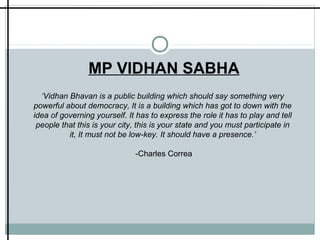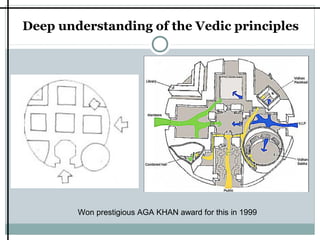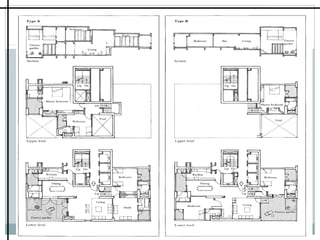Charles correa
- 2. Education 1946-1948 Inter-science. St. Xavier's college, university of Bombay 1949-1953 B.Arch., University of Michigan. 1953-1955 M.Arch., Massachusetts institute of technology. Professional Experience 1955-1958 Partner with G.M. BHUTA associates 1964-1965 Prepared master plan proposing twin city across the harbor from Bombay. 1971-1975 Chief architect to CIDCO 1975-1976 Consultant to UN secretory-general for HABITAT 1975-1983 Chairman Housing Urban Renewal & Ecology Board 1985 Chairman Dharavavi planning commission
- 3. Born on 1 September 1930 into a middle-class Catholic family in Secunderabad. Became fascinated with the principles of design as a child. At Michigan two professors who influenced him the most - Walter Salders and Buckminister Fuller. Kevin lynch , then in the process of developing his themes for image of the city triggered Correa’s interest in urban issues. ‘India of those days was a different place, it was a brand-new country, there was so much hope; India stimulated me.’
- 4. AWARDS 1961 Prize for low-income housing 1972 PadmaShri by the President of India 1980 Awarded an Honorary Doctorate by the University of Michigan 1984 Gold Medal- Royal Institute of British Architects 1985 Prize for the Improvement in the Quality of Human Settlements from the International Union of Architects. 1986 Chicago Architecture Award. 1987 Gold Medal- Indian Institute of Architects 1990 Gold Medal (International Union of Architects) 1994 The Premium Imperial from Japan society of art. 1999 Aga khan award for vidhan sabha, bhopal
- 5. Diversity In Bombay - Salvacao Church at Dadar ; Kanchenjunga Apartments In Goa for Kala Academy In Ahmedabad - Gandhi Smarak Sangrahalaya ; Ramkrishna House Delhi - The LIC Centre; British Council Building Kerala - Kovalam Beach Resort Hotel Andaman - Bay Island Hotel in Port Blair His Architectural utility and grandeur was spread over the subcontinent
- 6. Principles Few cardinal principles in his vast body of work Incrementality Identity Pluralism Income generation Equity Open-to-sky space Disaggregation. Belapur housing being the one project where he has literally used these principals
- 7. Architect, planner, activist and theoretician, an international lecturer and traveler Correa's work in India shows a careful development, understanding and adaptation of Modernism to a non-western culture. Correa's early works attempt to explore a local vernacular within a modern environment. Correa's land-use planning and community projects continually try to go beyond typical solutions to third world problems. India's first man of architecture has a very simple philosophy: "Unless you believe in what you do, it becomes … boring,"
- 8. Correa and Corbusier Like most architects of his generation he has been influenced by Le Corbusier , but by his response to the Mediterranean sun with his grand sculptural decisions he believes that Corbusier’s influence in the colder climates has not been beneficial because these heroic gestures had to withdraw into defensible space, into mechanically heated (and cooled) interiors of the building. On way back to Bombay in 1955 - saw the Jaoul House (le Corbusier) in Paris under construction. He said: ‘I was absolutely knocked out . It was a whole new world way beyond anything being taught in America at that time ,then I saw Chandigarh and his buildings in Ahmedabad . They seemed the only way to build.”
- 10. MP VIDHAN SABHA ‘Vidhan Bhavan is a public building which should say something very powerful about democracy, It is a building which has got to down with the idea of governing yourself. It has to express the role it has to play and tell people that this is your city, this is your state and you must participate in it, It must not be low-key. It should have a presence.’ -Charles Correa
- 11. Deep understanding of the Vedic principles Won prestigious AGA KHAN award for this in 1999
- 16. The building is located in the centre of Bhopal. Since the main access road is not axial , but swings towards the site in a rather casual manner , the plan of the building developed is as a circle, so it could have an autonous unity and presence, regardless of the direction from which it is approached. References of this circular form are – parliament building in New Delhi, Buddhist stupa near Sanchi.
- 17. The plan is a pattern of gardens within gardens, divided into 9 squares . The five central ones are halls and courtyards , while the 4 corner positions are occupied by The Vidhan Sabha , The Vidhan Parishad, Central library, and Combined hall. It also contains a host of other facilities : offices, cabinet rooms, cafeterias, common rooms for security staff etc.. According to the requirements there are 3 main entrancesfor public, VP’s, MLA’s While moving along verandah and overlooking courtyards and gardens – as in traditional architecture of India.
- 18. The whole building presents as extremely pleasing vision of powerful curves and straight vertical and horizontal lines.
- 21. Correa has used open to sky courtyards and a labyrinthine pattern of pathways to organise the complex requirements of adminstrative and legislative functions.
- 23. The whole composition is enclosed by a wall that defines its exterior form like a circular inner city- a model of the city of Baghdad. This approach has generated an interesting roofs cape and skylines, too often missing in contemporary architecture, the use of gateways and domes and a tower to develop the imagery of this landmark complex is very much in the tradition of the harmonic order found in the traditional architecture of islam
- 24. KANCHENJUNGA APARTMENTS The building had to be oriented east – west to capture prevailing sea breeze and views to the city.
- 25. But also the orientation for hot sun and heavy rains This building has 32 different apartments with 4 types of flats varying from 3 to 6 bedrooms. Interlocking of these variations expressed externally by shear end walls that hold up the cantilevers Minimalist surfaces cut away to open up double-height terrace gardens at the corners Complex spatial organization of living spaces
- 26. Superficially, this 28story tower, with its concrete construction and large areas of white panels, bears a strong resemblance to modern apartment buildings in the West Tower’s proportion 1:4 (21 sqm and 84 m high)
- 27. Garden terraces actually a modern interpretation of a feature of the traditional Indian bungalow: the verandah Each apartment provided with a deep, twostory-high garden terrace that is oriented away from the sun so as to afford protection from the elements
- 33. Accommodates 300 guests, Center for massages and yoga, Water sport etc. The master plan does not concentrate all the facilities in one area, but generate a large number of potential growth points, thus allowing a more flexible response to future demands . The Guest rooms come in 3 configurations-: 1.On the edge of the beach hidden under the palm trees . They are suites for longer stay with cooking facilities etc. 2. Overlooking the beach there are 100 guests rooms. Here the facilities are such that every room gets its own private sundeck.. 3.Between these two are private detach housing units . Construction is in traditional vernacular of Kerala- Plaster walls with red tiled roofs Other pavilion consists of little Bamboo chhatries with coir matins on the floor and local Kerala handicrafts.
- 39. Gandhi Smarak Sangrahalaya Material used: Tiled roof Brick wall Stone floor Wooden floor Light and ventilation by operable wooden louvers These elements combine to form a pattern of tiled roofs which are grouped in casual meandering pattern, creating a pathway along which the visitors progresses towards the centrality of the water court
- 40. Philosophy: Successfully shows the life of Gandhiji Minimalist architecture Material honesty Contemporary architecture Glow of spaces Gandhi ashram Water court at center
- 46. Correa is always receptive to feedback but he has never compromised or changed his designs he really believes in. "I listen very carefully. But I would rather lose the client than make changes I don't believe in"
- 47. BELAPUR HOUSING
- 48. Project demonstrates how high density housing (500 people per hectare) can be achieved in a low-rise typology, while including (open to sky spaces) and services, like schools, that the community requires Overriding principle - to give each unit its own site to allow for expansion (Incrementality) Units are Malleable so that they can be colonized by occupants, and modified to their social/cultural/religious needs (Identity) Houses constructed simply and can be built by traditional masons and craftsmen - generating employment for local workers (Income generation) several plans exist that cover the social spectrum, from squatters to upper income families (Pluralism) Yet, the footprint of each plan varies little in size (from 45 sqm to 70 sqm), maintaining equity (fairness) in the community
- 50. Small shared courtyard 8mx8m around which seven houses are grouped. The sites themselves vary in size only marginally (from 45 to 70 sq m) The houses are structurally simple , can be built and altered by local mistries
- 56. THANK YOU …























































